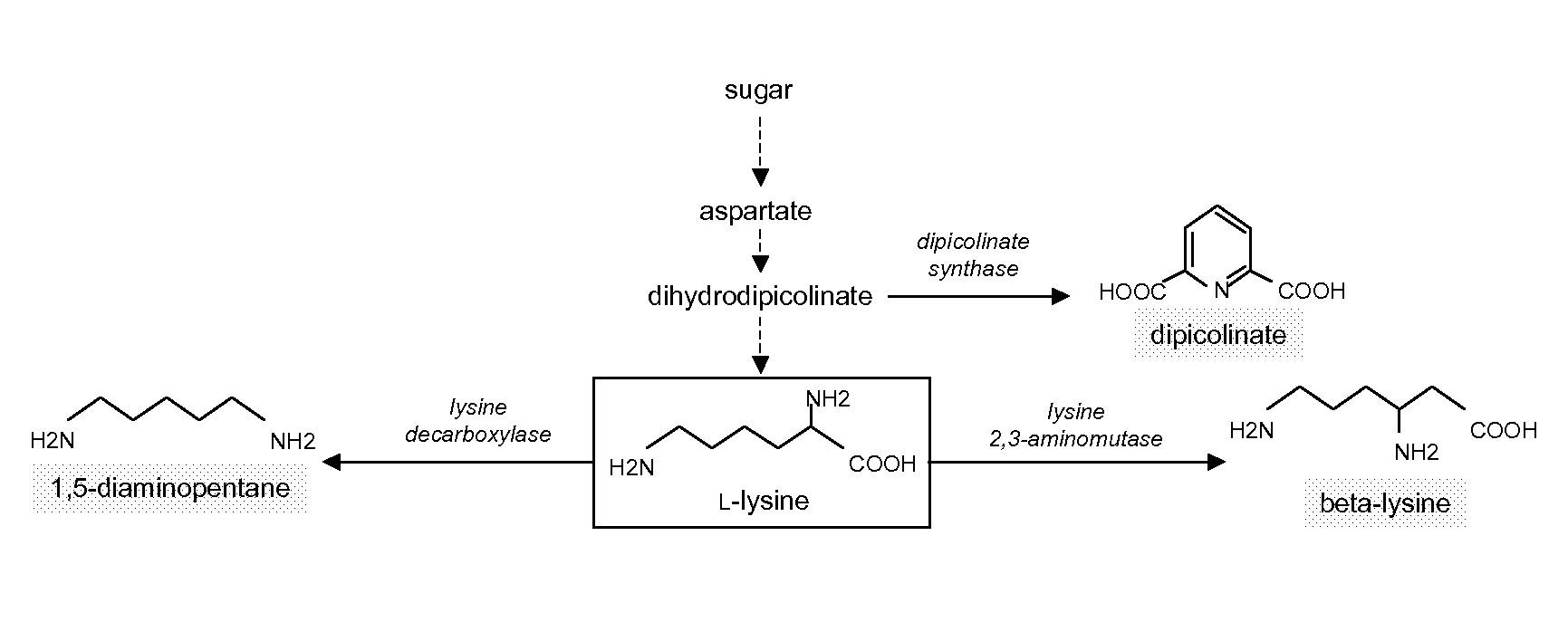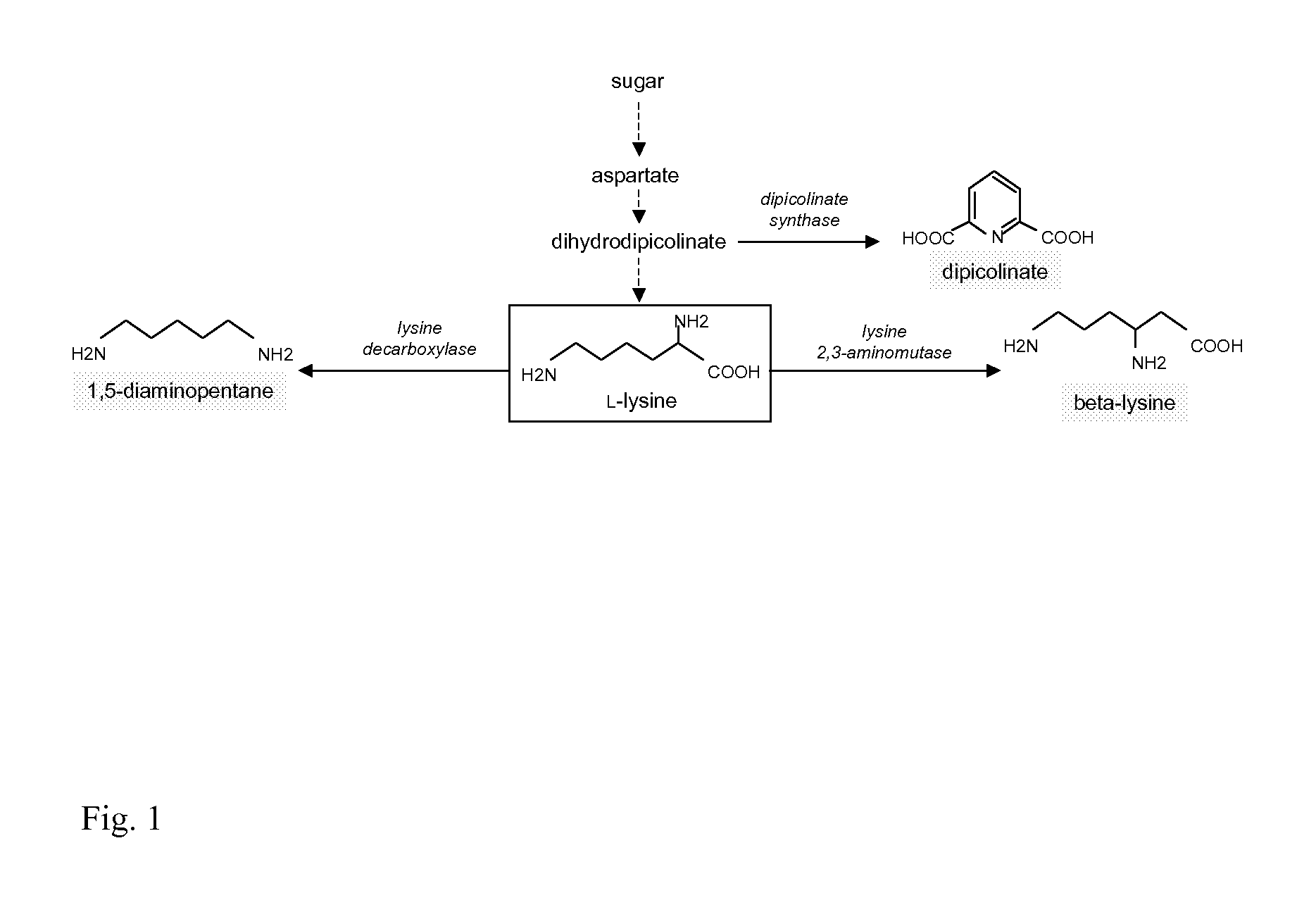Production Process for Fine Chemicals Using Microorganisms with Reduced Isocitrate Dehydrogenase Activity
a technology of isocitrate dehydrogenase and production process, which is applied in the direction of microorganisms, microorganisms, fermentation, etc., can solve the problems of expensive starting materials, time-consuming -lysine, and racemic mixtur
- Summary
- Abstract
- Description
- Claims
- Application Information
AI Technical Summary
Benefits of technology
Problems solved by technology
Method used
Image
Examples
example 1
Reducing Expression of Isocitrate Dehydrogenase (ICD) and its Effect on Lysine and Trehalose Production
[0294]1.1 Construction of a Corynebacterium glutamicum Strain with Reduced ICD Activity
[0295]To reduce the activity of isocitrate dehydrogenase (Genbank Accession code X71489), a change in codon usage was made. The original start codon ATG was replaced by a GTG. The manipulation was made on the only chromosomal copy of the icd gene of Corynebacterium glutamicum. The subsequent measurement of ICD activity directly allows a readout of the effect.
TABLE 1Overview codon exchange in ICDaffected aminonamedescriptionacid positionsICD ATG → GTGChange of the start codon from1 (Met)(synonym: ICD ATG-ATG to GTGGTG)
[0296]The sequence of ICD ATG-GTG is depicted in FIG. 2 a) of PCT / EP2007 / 061151. To introduce this mutation into the chromosomal copy of the icd coding region, a plasmid was constructed which allows the marker-free manipulation by 2 consecutive homologous recombination events.
[0297]T...
example 2
Strain Construction for Methionine Production and Effect on Methionine Productivity
[0359]In a further experiment described in PCT / EP2007 / 061151, isocitrate dehydrogenase carrying the above mentioned ATG-GTG mutation in the start codon (compare example 1.1) was cloned into pClik as described above leading to pClik int sacB ICD (ATG-GTG) (SEQ ID NO:15 of PCT / EP2007 / 061151, SEQ ID NO:5 of present sequence listing shows the vector insert). Subsequently, strain M2620 was constructed by campbelling in and campbelling out the plasmid pClik int sacB ICD (ATG-GTG) (SEQ ID NO:15 of PCT / EP2007 / 061151) into the genome of the strain 0M469. The strain 0M469 has been described in WO 2007 / 012078.
[0360]The strain was grown as described in WO 2007 / 020295. After 48 h incubation at 30° C. the samples were analyzed for sugar consumption. It was found that the strains had used up all added sugar, meaning that all strains had used the same amount of carbon source. Synthesized methionine was determined by ...
example 3
Use of Strains with Reduced ICD Expression Level in Diaminopentane Production
[0362]Construction of Strains with Modified ICD Expression Level
[0363]The plasmid pClik int sacB ICD ATG→GTG (see example 1.1, synonyms: pClik int sacB ICD (ATG-GTG), pClik int sacB ICD ATG-GTG, vector insert see SEQ ID NO:5) is used for construction of diaminopentane producing strains with modified ICD expression level in comparison to the host strain.
[0364]The parent strain used is a 1,5-diaminopentane (1,5-DAP) producer derived from C. glutamicum wild type strain ATCC 13032 by incorporation of a point mutation T311I into the aspartokinase gene (NCgl 0247) and subsequent amplification of the gene dosage by addition of a strong promoter Psod, duplication of the diaminopimelate dehydrogenase gene (NCgl 2528), disruption of the phosphoenolpyruvate carboxykinase gene (NGgl 2765) and chromosomal integration of the E. coli lysine decarboxylase gene (Kyoto Encyclopedia of Genes and Genomes, Entry JW0181). Each o...
PUM
| Property | Measurement | Unit |
|---|---|---|
| temperature | aaaaa | aaaaa |
| temperature | aaaaa | aaaaa |
| volume | aaaaa | aaaaa |
Abstract
Description
Claims
Application Information
 Login to View More
Login to View More - R&D
- Intellectual Property
- Life Sciences
- Materials
- Tech Scout
- Unparalleled Data Quality
- Higher Quality Content
- 60% Fewer Hallucinations
Browse by: Latest US Patents, China's latest patents, Technical Efficacy Thesaurus, Application Domain, Technology Topic, Popular Technical Reports.
© 2025 PatSnap. All rights reserved.Legal|Privacy policy|Modern Slavery Act Transparency Statement|Sitemap|About US| Contact US: help@patsnap.com



